Putting the “lite” in “Roguelite”
By AtheistPreacher 15 Comments
Rogue Legacy 2 has just hit version 1.0, and I knew I wanted to post something about it for the release. I’m not sure I would call what follows a “review,” if only because I love this game so much that I find it hard to be all that objective about it (for the record: I’ve logged 174 hours on the early access version of the game). But hopefully someone out there will find it informative and be encouraged to give it a shot.
Background: RL1 and RL2 early access
In the lead-up to RL2’s 1.0 release, I noticed some people claiming that the first Rogue Legacy actually *invented* the Roguelite genre when it was released in 2013. Strictly speaking, I don’t think this is actually true, as the “lite” elements of Roguelites had been around for some time, even if in a somewhat embryonic and diffuse form compared to the fairly distinct genre we see today. However, it appears that Cellar Door Games may, in fact, have been the first game developer to coin the term.
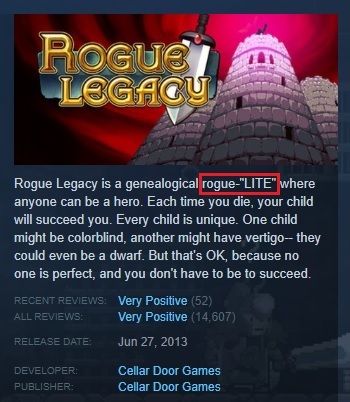
Regardless, what is not in dispute is that the original Rogue Legacy helped to define and popularize the “lite” elements in Roguelites. By putting a heavy focus on upgrading your character between runs, it injected an element of character-building power fantasy into the more established Roguelike genre, which eschewed permanent upgrades in favor of a uniform starting point for each run.
I liked RL1 a lot. I logged 40.7 hours on it on Steam, maxing out the upgrades and clearing multiple NG+ cycles, and also bought the game on Playstation. In 2013, it really was something new. Games like Dead Cells and Hades were not yet a thought. I just knew that I really enjoyed the idea of continuing to power up my character on the way to finally clearing the game. It was fun to keep starting new runs knowing that I was not only getting better at playing the game myself, but was also entering with a continually more capable character.
Fast-forward to August 2020, when Cellar Door Games released an early build of Rogue Legacy 2 on Steam Early Access. The global pandemic had properly begun about five months earlier; weird to think that the game’s entire front-facing development cycle took place during COVID. Anyway, GB did an “Unfinished” and other games press did their own coverage.
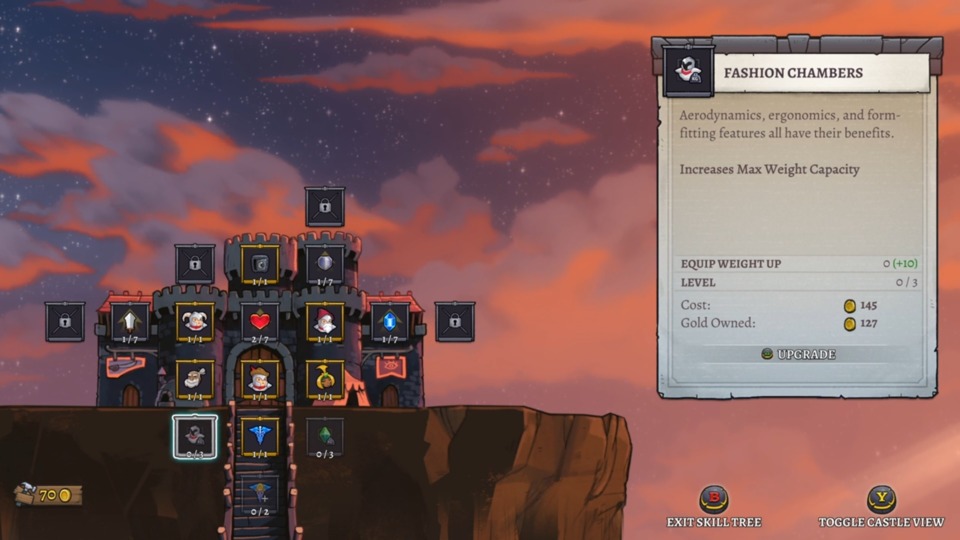
Though the core gameplay felt pretty good even at this early stage, the game at this point was, quite honestly, very content-light and thin. It had only one “biome,” a small and uninteresting bunch of upgrades, few classes, and (to the best of my recollection) no completed bosses to fight. There are some early access games that are first released at a point where they’re already worth their asking price; RL2 was not one of them. At the initial early access price of $15.99 (which has since increased to reflect a more complete product—it’s now $24.99), you were investing on the promise of the game rather than what was actually there. I think I’d go so far as to say that Cellar Door Games probably made a mistake by releasing it as early as they did; the game might have earned better word of mouth if they had waited a few more months.
But as time went by and regular large content updates happened, the game rather quickly surpassed its predecessor in virtually every way imaginable. Let’s talk about how, shall we?
Character classes
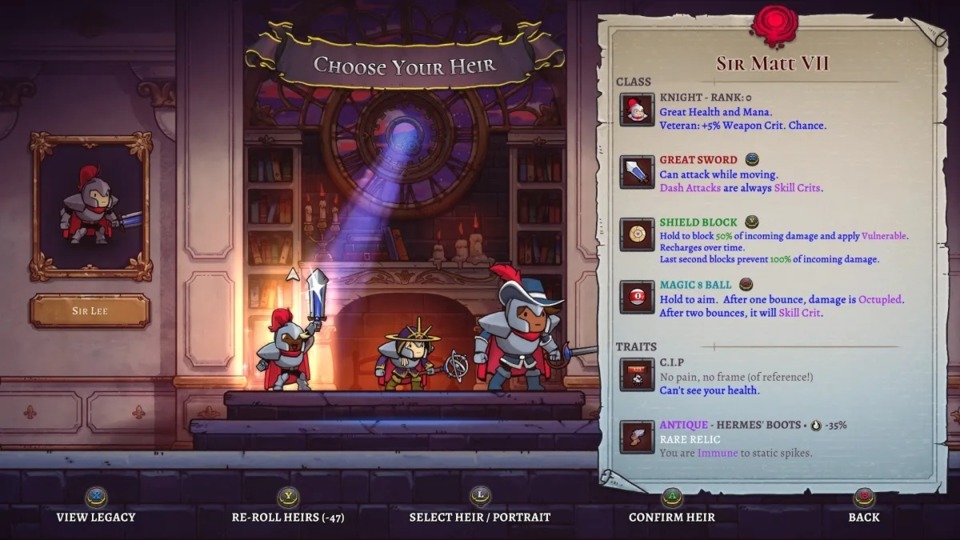
In RL1, classes seemed like a big part of the game, but in retrospect, they just weren’t all that well-differentiated. All carried the same basic sword melee weapon, and while each had a special ability, the differences were mainly in the stats; some had more HP but less mana, others had a high chance to critically strike but had low base attack power, etc. After a while a few classes seemed to simply surpass others, and runs could start to feel pretty same-y.
The big thing that RL2 does to improve on the class system is that it gives each class an entirely unique starting weapon, along with other special properties and abilities unique to that class. Sure, there’s still the basic knight with the same sword from RL1. But now there’s also:
- Valkyries (my personal favorite), whose spears can be aimed up or down in addition to forward, and can be quickly twirled to reflect incoming projectiles;
- Barbarians, who use huge axes for massive damage and can also yell to temporarily freeze enemies in place;
- Rangers, who use a bow that can be aimed in any direction, and can create platforms (on a short cooldown) to fire from wherever they wish;
- Bards, who play lutes that send out musical notes a short distance away that float in place, dealing periodic damage to enemies in range;
- Boxers, who build combos with quick punches that increase in damage with every hit.
And that’s just five of the fifteen classes. Each one has a unique playstyle, rather than simply being a different balance of core stats. The effect is, of course, that RL2 is much, much more replayable than RL1 ever was, simply due to the sheer variety of gameplay styles on offer.
Emphasis on the “lite”
RL2 is also just a much bigger game than its predecessor in just about every way you can conceive of. In addition to having more classes that are more meaningful in their differences, it has six “biomes,” each with its own boss, next to the original’s four, more weapons and armor to buy and upgrade, more “runes” to unlock that do things like add lifesteal to your attacks or give you more dashes or jumps (you can eventually jump some ridiculous number of times, something like twelve(!) before hitting the ground), more permanent “castle” upgrades to buy, and even a special currency that will allow you to keep upgrading your stats beyond their normal limits.
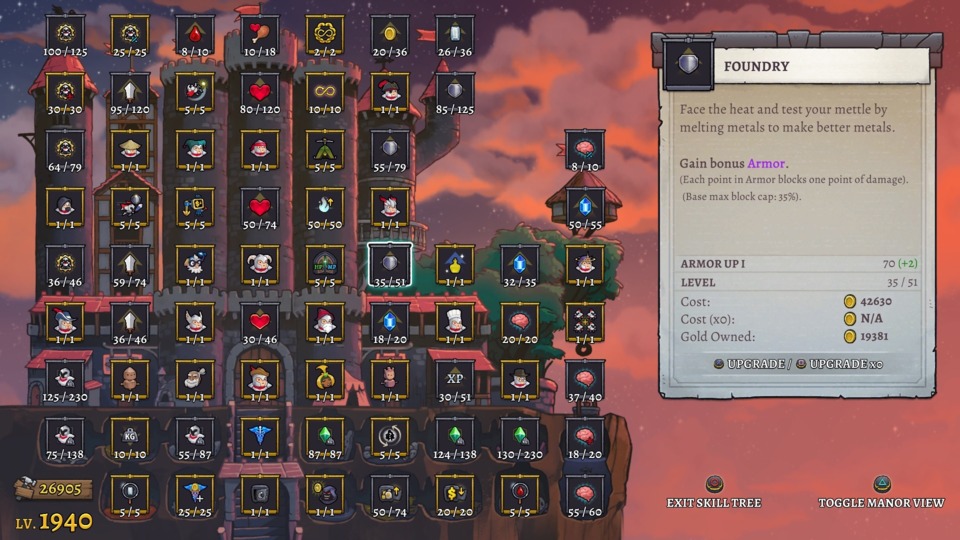
The fact that this game just has so many friggin’ permanent upgrades to buy is why, as I noted at the outset, I put 174 hours into the early access version of the game and reached the pre-release cap of NG+30. Yes, you read that correctly. NG+30. And I still have stuff to upgrade. Moreover, in late November I did some calculations that suggest to me that the 1.0 release may allow you to go all the way to NG+100 if you’d like (obviously I can’t confirm this at the moment, ask me again in a few months XD). Considering each run will usually take multiple hours to complete, that is an awful lot of game.
Maybe that simply sounds exhausting to you, and you’d prefer to just clear the game once or twice and move on. Which is fine! But if you’re the kind of person who likes to keep seeing the numbers go up, then I don’t think you need to worry that you’re going to eventually run out of upgrades to buy. The vast majority of players will have moved on to another game long before they’re in danger of maxing everything out. Hence one of the other problems I ran into with RL1—that I had bought all the upgrades and had achieved basically all there was to achieve in forty hours—really isn’t an issue with the sequel.
Play it your way (especially with regard to difficulty)
I could tell you that RL2 has no formal difficult settings, and while that would technically be true, it’s also grossly disingenuous. The truth is that RL2 has all sorts of granular settings that let you play the game the way you want to play it, to get the experience you want to have.
The most obvious of these is the “House Rules.” These are settings that will let you:
- Increase (up to 200%) or decrease (down to 50%) enemy health;
- Increase (up to 200%) or decrease (down to 50%) enemy damage;
- Slow down time while aiming projectiles (like spells, arrows, or bullets);
- Enable flight;
- Disable enemy contact damage.
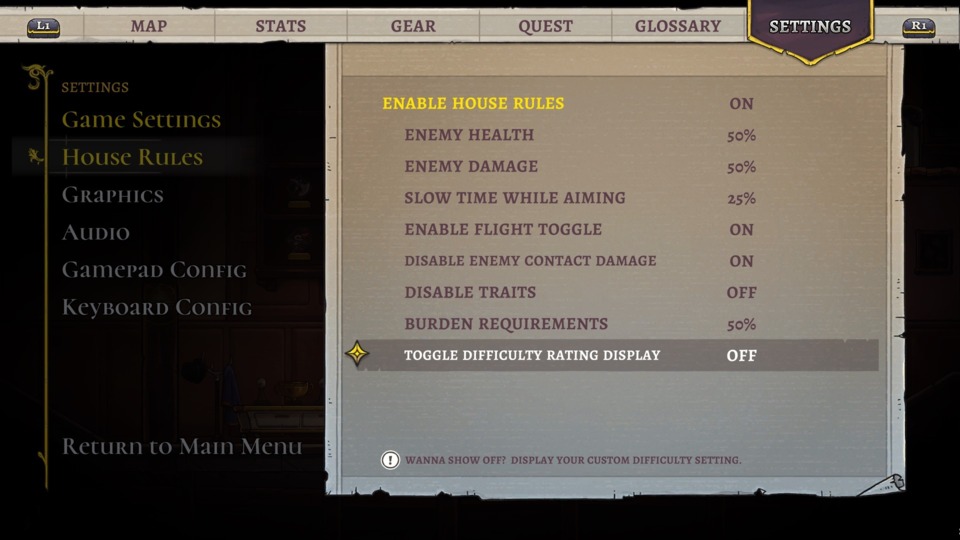
Enabling any or all of these options will not disable achievements or progression. In fact, there’s even an achievement for altering the House Rules for the first time. So if you’re someone who worries that the game’s difficulty is going to be a little too brutal for you, well, worry not. You can make it as easy (or as difficult) as you’d like.
And these are far from the only options that alter the difficulty and experience of a run.
- You can add “burdens” that do things like increase enemy projectile speed, or give enemies life steal, or make the world bigger, or make hazards/spikes deal more damage.
- You can toggle on “Prime” versions of bosses that have new tricks up their sleeves; the first boss, for instance, goes from firing straight-shot projectiles to projectiles that home in on you.
- Character “traits,” randomized upon picking a new character/heir after dying (another returning feature from RL1), will do all sorts of wacky things, with the more negative ones balanced by giving you a gold bonus—stuff like turning the screen upside down, or making the screen temporarily go black every time you take damage, or turning you into a “pacifist” that cannot directly attack enemies at all.
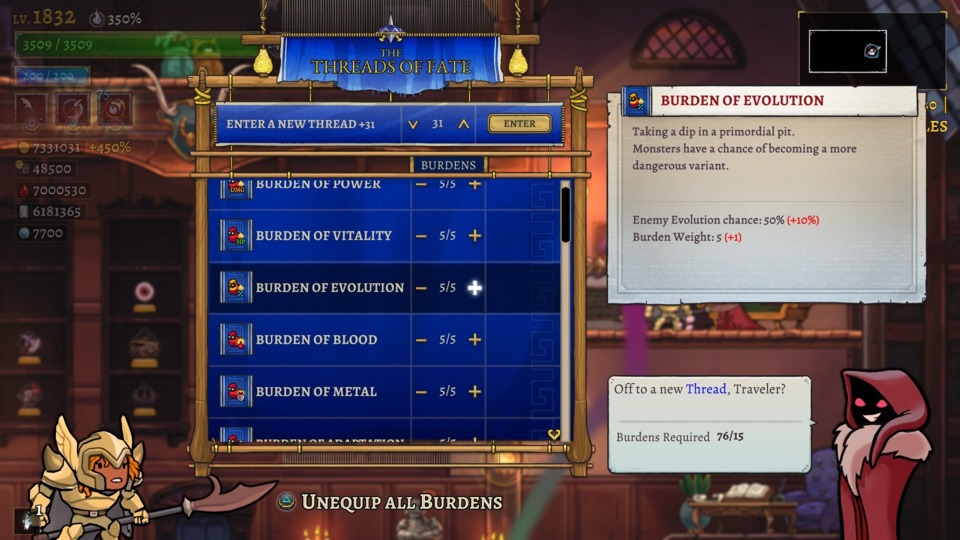
And there are other game mechanics that I haven’t even mentioned yet, there’s just too much to talk about with this game, and I don’t have all day to write this thing. One other important mechanic: the relic/resolve system, which allows you to pick up powerful relics each run (they are lost upon death) at the cost of maximum health, depending on how high your “resolve” is. These do things like add a fire damage-over-time to your attacks, to changing your one big jump into three smaller ones, to adding more time to your invincibility window after taking damage, and even more esoteric things.
What a sequel should be
All in all, RL2 basically just completely blows RL1 out of the water. The amazing thing is that this really isn’t a knock on the first game so much as it is a glowing endorsement of the sequel, which truly seems to have surpassed and enlarged upon its predecessor in every way that matters. Hell, I didn’t even talk at all about the overhauled “2.5D” art style, which is pretty gorgeous. Nor did I really spend any time spelling out the simple fact that the controls and movement/core gameplay feel tight and precise and just plain good all-around. Better than merely good, really. And though I’m not going to talk any more about that, it’s only because such things are so hard to define and describe, anyway. You’ll just have to give it a whirl and test out the game feel for yourself (and meanwhile we’ll all leave Jeff G to test the mouth feel).
I saw in a recent article that one of RL1’s original two developers has said that he no longer bothers playing the first game at all anymore, and it’s easy to see why. Once you start playing RL2, it’s hard to go back. The Roguelite genre has really exploded and gone some places in nine years, and Cellar Door Games has risen to the task of creating a game that can compete with the best examples of the genre. I only hope the game finds the audience it deserves.
The game’s on sale for 20% off ($19.99) on Steam through May 9. If you’ve ever liked a Roguelite before, I think I can pretty safely say that this one is going to be money well-spent.